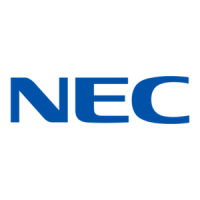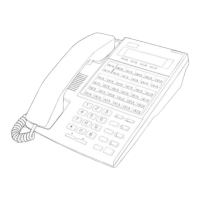22 ◆ Features DSX Product Description
Using Account Codes and Speed Dial
To simplify Account Code operation, Personal and System Speed Dial bins can contain Account Codes.
Keep the following in mind when using Speed Dial and Account Codes:
❥ The Account Code can be either the first or last entry in the bin, and must be preceded and followed by
the # character. For example, the Account Code 1234 must be entered as #1234#.
❥ The Speed Dial bin can contain an Account Code followed by an outside number, or just the Account
Code. The Account Code must be preceded and followed by a # entry. If the bin contains just the
Account Code, the user must be sure to press the bin key before dialing the outside number.
❥ If the system has Verified Account Codes enabled, the Account Code entered in the Speed Dial bin must
match an entry in the Verified Account Code Table.
❥ If the Speed Dial bin does not contain an Account Code, the user must enter the Account Code manually.
If Forced Account Codes are enabled, the system requires the user to enter the Account Code before it
outdials the stored Speed Dial number.
❥ An extension user can preselect a line for a Speed Dial call.
Using Account Codes with Last Number Redial and Save
Last Number Redial and Save do not store Account Codes. This means that the user must manually enter an
Account Code to have it included with a call dialed using Last Number Redial and Save. If Forced Account
Codes are enabled, the system requires the user to enter the Account Code before it outdials the stored num-
ber saved by Last Number Redial or Save.
An extension user can preselect a line for a Last Number Redial or Save call.
Account Codes and Emergency Calls
Account Codes are never enforced for emergency (911 and 1+911) calls.
Alphanumeric Display
The 22- and 34-Button Display Telephones have a three-line, 24-character per line alphanumeric display.
The first line displays the date and time (while idle) and feature status messages. The second line is used
extensively by IntraMail. The third line displays the Soft Key definitions.
The 34-Button Super Display Telephone has a nine-line, 24-character per line alphanumeric display. The
first line displays the date and time (while idle) and feature status messages, just like the 22- and 34-Button
Display Telephones. The second line is used extensively by IntraMail. Lines 4-9 are the comprehensive
Super Display Telephone soft key definitions.
❥ To learn more about the display telephones:
- see 22-Button Display Telephone on page 4
- see 34-Button Display Telephone on page 5
- see 34-Button Super Display Telephone on page 6
❥ To learn more about the Soft Keys, see Interactive Soft Keys (page 50).
Attendant Call Queuing
An unlimited number of callers can queue for the attendant. The callers hear ringback while they wait for the
attendant to answer — not busy tone. If you have the attendant as the overflow destination for Direct Inward
Lines, for example, unanswered DILs will “stack up” at the attendant until they are answered.
The Alphanumeric Display messages help the display telephone user process calls, identify
callers and customize features.
Attendant Call Queuing helps minimize call congestion in systems that use the attendant as
the overflow destination for unanswered calls.

